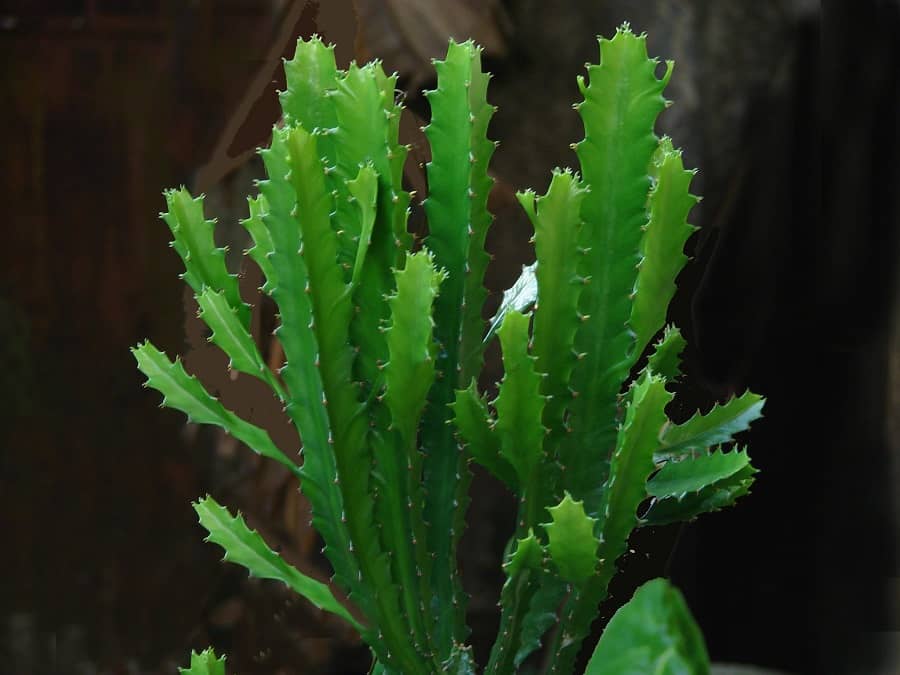Euphorbia trigona, is a species of the genus Euphorbia native to south-eastern Africa (Graboon River).
Euphorbia Trigona ‘Rubra’ is a plant where its stems and leaves are tinged with red-purple.
The stems are triangular, although in some cases they can appear with up to 4 edges.
With the proper conditions, this succulent grows very fast; it can measure up to 4 meters, forming large upright columns.
Euphorbia trigona ‘African Milk Tree’ Care
Substrate:
Above all, it requires good drainage. Otherwise, it does not require a specific substrate. But when you use one, its recommended, 1/3 is sand to facilitate drainage.
If the plant is in the garden, it must have excellent drainage; It is advisable to plant a 1m hole fill it with pumice, previously washed river sand or a 50% mixture of universal cultivation substrate with perlite.
If planted in a pot, fill with any type of substrate. You can also use a mixture in equal parts of sand and well-decomposed leaf mulch.
Watering:
You should avoid watering your plant too much since excess watering will damage the stem foot, and the plant will die. The waterings must be sparse, but regular and always when the substrate is dry.
In summer, it needs to be watered more, so that the substrate never gets dry, but always avoiding waterlogging.
In winter, on the contrary, all the waterings can be avoided.
Fertilizer:
It must be applied during the spring and summer and must be fertilized with fertilizers for cacti and other succulents, following the instructions specified on the product package.
You can do it in fall too.
Temperature:
Resists cold, but not frost. It’s best to avoid temperature below 8ºC/46°F, but if it drops to 0ºC/32°F, it will suffer damage but not irreversible, as it would if it drops to -1ºC/30°F or less.
It needs warm climates between 20ºC/68°F and 28ºC/82°F to develop comfortably.
As much as you can, try to provide constant temperatures because although it may seem somewhat unnecessary, a stable temperature without sudden changes will favor its development.
Diseases:
It is quite strong against pests and does not usually present an insect problem. The whitefly could harm it, but you can quickly eliminate it with the application of insecticides.
It is important to be cautious with watering and never overdo it; this could lead to fungus or rotting problems.
On the other hand, if you observe that the leaves of your Euphorbia Trigona ‘african milk tree’ fall off for no apparent reason, it could be due to the fact that the plant is subjected to temperatures below 10°C/50°F.
Transplant:
Euphorbia trigona will be planted in the garden in spring when the risk of frost has passed.
If it’s kept in a pot, it must be passed to a larger pot every 2 years.
But you will usually know when to do it since the roots of the succulent will protrude through the drainage holes of the pot.
In that case, plant it in a larger pot and make sure to do it in spring as high temperatures will better support the change and adhere better to the substrate.
Illumination:
The Euphorbia trigona is a plant that, if the climate is warm and frost-free, must be grown outdoors year-round, in full sun.
But yes, you can have it a greenhouse.
On the other hand, if you have an interior patio with windows through which a lot of sunlight passes or a very well lit room (with natural light), it can grow well there.
Propagation:
Euphorbia trigona produces seeds, but they are so rare in cultivation that the only effective way to multiply them is by stem cuttings, taken in spring.
You have to let the wound dry for a week, protected from direct sun, and then plant it in a pot with vermiculite.
For a greater chance of success, you can impregnate the base with homemade roots. Thus it will issue its own roots in 10-14 days or so.
Pruning:
It’s not recommended. It is a plant that, like all Euphorbia, contains latex inside, which is a substance that causes itching and stinging. But also, if the plant loses a lot, it weakens and loses beauty.
